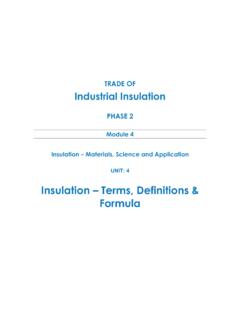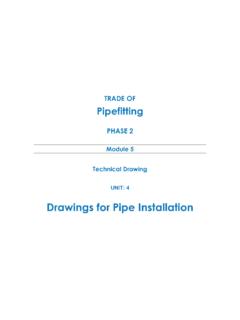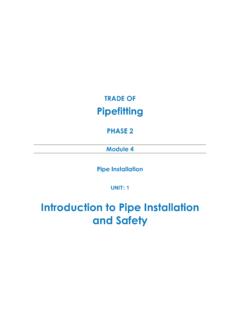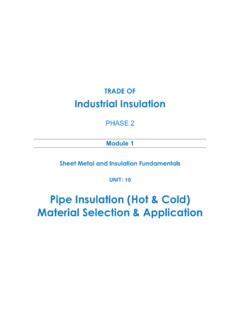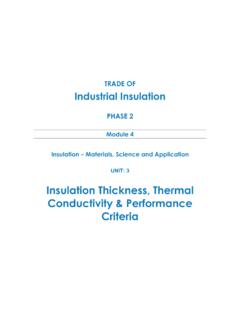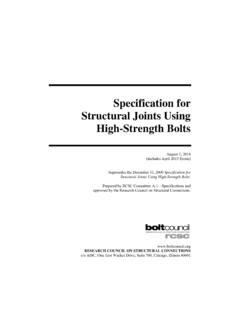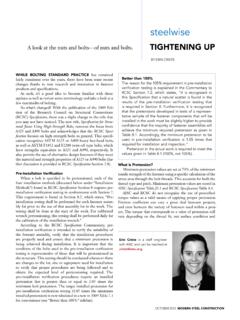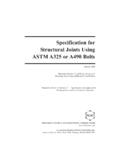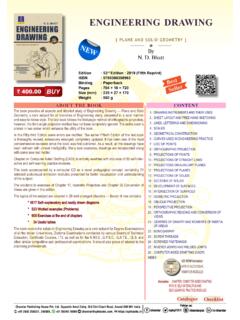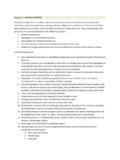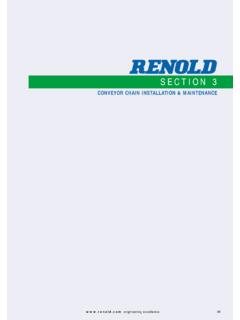Transcription of Radius Bend (Duct) - eCollege
1 TRADE OF Industrial Insulation PHASE 2 Module 5 Ductwork & Vessels unit : 2 Radius Bend (Duct) Produced by In cooperation with subject matter expert: Michael Kelly SOLAS 2014 Module 5 unit 4 Industrial Insulation Phase 2 Radius Bend (Duct) Revision , August 2014 Table of Contents Introduction .. 1 unit Objective .. 2 Measuring and Sketching .. 3 Measuring Finding the Radius of a Rectangular Duct Bend .. 3 3D Sketching Isometric Projection .. 3 First and Third Angle Orthographic Projection .. 3 Calculation of Insulation Allowances .. 3 Area Calculation for Sheet Size .. 4 Use of Manufacturers Data Sheets .. 4 Marking Out and Fabrication.. 5 Marking-Out Techniques and joint Selection for Large Radius Bends5 Pattern Development Parallel Line Development.
2 5 Accurate Cutting and Forming of a Radius Bend .. 6 Zed-Bar Fabrication .. 6 Bends Strengthened by Cross Breaking/Pressing .. 6 Standing Seams .. 6 joint Weathering .. 6 Pressure and Force .. 7 Fitting of Insulation and Cladding .. 8 Select Appropriate Type of Insulation .. 8 Apply Insulation to Existing Bend Using Appropriate Fixings .. 8 Vapour Barrier .. 8 Cladding an Existing Radius Bend .. 8 Professional Approach to Material Use and Finish .. 9 Summary .. 10 Module 5 unit 4 Industrial Insulation Phase 2 1 Radius Bend (Duct) Revision , August 2014 Introduction A Radius bend is used in a ventilation ductwork system to change the direction of the system. Accurately measuring a Radius bend requires a number of skills including sketching, measuring radii, manufacturing techniques, use of scale drawings and working to a specification.
3 Module 5 Ductwork & VesselsUnit 1 Measuring: Ductwork & Other Large Areas unit 2 Rectangle to Round (Concentric) unit 3 Off-Centred Rectangle to Round unit 5 Offset (Duct) Rectangular unit 4 Radius Bend (Duct) unit 6 Hoppers (Rectangle to Rectangle) unit 7 Vessels: Storage & High PressureUnit 8 Moving Joints & Support SystemsUnit 9 Scale Drawing & Applications unit 10 Dressing Pieces Module 5 unit 4 Industrial Insulation Phase 2 2 Radius Bend (Duct) Revision , August 2014 unit Objective By the end of this unit each apprentice will be able to: Accurately measure a duct Radius bend using the correct techniques. Make a freehand sketch of a Radius bend. Accurately mark out and fabricate a 90 degree Radius bend. Prepare, insulate and finish a Radius bend for cladding. Module 5 unit 4 Industrial Insulation Phase 2 3 Radius Bend (Duct) Revision , August 2014 Measuring and Sketching Measuring Finding the Radius of a Rectangular Duct Bend When finding the throat Radius of a Radius bend we can use a number of methods such as: Use a flat steel square as shown and take the measurements from the square or use a tape rule or folding rule for taking the measurements.
4 Use a folding rule set at 90degrees (position the square as with the flat square) and read off the measurements. Position a straight edge (metal, timber etc) along one edge of the bend and take the measurements required. Note: No extra allowances shown for flanging or ship joints. Radius Bend Elevation. 3D Sketching Isometric Projection Refer to module 2 unit 2. First and Third Angle Orthographic Projection Refer to module 2 unit 2. Calculation of Insulation Allowances The allowances for insulation would be the same as for any square or rectangular duct. This equals the perimeter of the rectangular bend plus eight thicknesses of insulation. Refer to Module 5- unit 2 section Key Learning Points Measuring- Radius finding. Area calculation for sheet size and layout.
5 Marking out techniques for large radii. Module 5 unit 4 Industrial Insulation Phase 2 4 Radius Bend (Duct) Revision , August 2014 Area Calculation for Sheet Size A sample bend for calculation purposes is shown in the figure below. The size of the bend is H = 600mm, W = 400mm and the throat Radius R = 200 mm. Note: no extra allowance shown for flanging or slip joints. Radius Bend Isometric. Area Calculation (a) Cheek Size ( 2 no. Required) x x 2 no. = (b) Throat Wrapper Length Radius is 200mm so the diameter is 400mm Circumference of throat = (400mm x ) 4 = 314mm Area of metal for throat = 314mm x 600mm or x = . (c) Heel Wrapper Length Radius is 600mm or diameter is 1200mm. Circumference of throat = (1200mm x ) 4 = 942mm Area of metal for throat = 942mm x 600mm or x =.
6 (d) Total Area of Material Required for The Radius Bend + + = Note: No allowance has been added in the calculations above for a lock-form joint . Use of Manufacturers Data Sheets Refer to module 4 unit 5 - Glass mineral fibre and rockwool. Module 5 unit 4 Industrial Insulation Phase 2 5 Radius Bend (Duct) Revision , August 2014 Marking Out and Fabrication. Marking-Out Techniques and joint Selection for Large Radius Bends When making large fittings or bends, layout a reduced scale drawing of the fitting to determine the seam locations, keeping in mind to utilise the full length and width of standard sheet sizes of metal available. The choice of joints for a large duct bend would include standing seams to hold the cheeks together or the grooved seam/double seam, with the Pittsburgh Lock for corner joints and the grooved seam/double seam for the wrappings if required.
7 For the cladding bend the standing seams or lap seam could be used to hold each section of the bend together with the corner lap seam being used on the corners. The advantage of using the Standing Seam is that it is strong, has good appearance and can be assembled and secured for a good joint . The disadvantage of using the lap seam on the cheeks especially if it is wide is that it tends to deflect up and down unless it is well supported underneath. The choice of joints or seams selected, will depend on the knowledge and skills of the operator. Large Radius bends are generally marked out on a sheet using a set of trammel points. Refer to module 1 unit 3 section Hand tools. Pattern Development Parallel Line Development See Module 2 unit 3 Parallel Line Development.
8 Key Learning Points Notch and crimping Fabrication of a duct Radius bend Neat workspace layout and professional work ethic Zed-bar Fabrication joint weathering Strengthening techniques Tanding seams Cross pressing Force and pressure. Module 5 unit 4 Industrial Insulation Phase 2 6 Radius Bend (Duct) Revision , August 2014 Accurate Cutting and Forming of a Radius Bend As the cladding bend is a large radii bend which is made in a number of sections due to its large size, care and attention to detail is important. After the joints and method of manufacture has been decided. The next thing to do is develop the patterns. This is shown in Module 2 unit 5 Parallel line development. When the patterns are developed and measurements checked, it is time to cut them out.
9 This is done by using the guillotine, power shears and final notching with a snips. After cutting, the various parts are folded and formed (cross breaking, rolled, swaged and crimped) before assembly. Zed-Bar Fabrication Z-bar sections are fitted to ductwork to support and fix the metal cladding. They are made to match the insulation thickness and are fabricated from thick material. They are cut and folded to suit the outside dimensions of the insulated duct and are secured with pop rivets or self-tapping screws. Bends Strengthened by Cross Breaking/Pressing Stiffening of a duct bend is carried out to strengthen the metal (cheeks and wrappers) and to reduce or stop drumming in the bend and ductwork. This helps to reduce noise in the system.
10 For cladding, it helps to strengthen the metal and enhance the overall appearance of the job. Standing Seams The standing seams used on ductwork should be a good close fit and be secured with pop rivets or bolts. For cladding, he standing seam should also be a close fit and should be secured with pop rivets. Seams should be finished with a sealant to stop penetration of moisture into the seams and the insulation underneath. joint Weathering Joints on the cladding should be weathered correctly, close fitting and finished with a sealant to stop moisture penetration. Module 5 unit 4 Industrial Insulation Phase 2 7 Radius Bend (Duct) Revision , August 2014 Pressure and Force Pressure depends on two things: The Force (in Newton s) and, The Area it s pressing on (in square metres).
